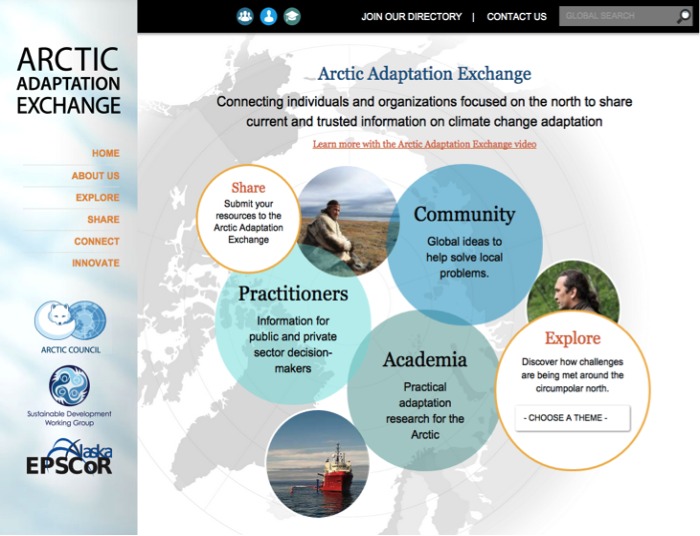By: Vanessa Raymond, Project Manager, Geographic Information Network of Alaska
Arctic communities possess a wealth of knowledge about landscape and ecosystem changes in their regions. This knowledge is an incredible resource that needs to be shared across the circumpolar North and beyond, to non-Arctic research and policy-making centers. The Arctic Adaptation Exchange portal, a project of the Sustainable Development Working Group and Alaska EPSCoR, is positioned to support the flow of knowledge between Arctic communities for adaptive and resilient capacity building in the face of much change. As an open and web-based platform, this information is also available for concerned researchers and policy-makers.
To truly support resilient Arctic communities the Arctic Adaptation Exchange (AAE) is expanding its existing platform to allow them to share innovations, problems, and solutions for resilient response to climate change. While currently the AAE is a vibrant place to share research of all kinds across a variety of thematic and Arctic regional contexts, it has the capacity to support and engage Arctic community members in a more dynamic role. Through the Community Observation Network for Adaptation and Security (CONAS) and SnowChange the AAE team has identified 16 communities around the circumpolar region who are willing to participate in sharing experience of and solutions to climate change. These include communities in the U.S., Russia, Norway, Sweden, and Finland. The AAE continues to seek community partners across the circumpolar North.

Through an accessible web platform the planned re-design of AAE serves as both information resource and climate change witness for Arctic communities. This redesign includes adding a user forum for frank discussion, and recalibrating the AAE "Explore" map. The map will be repurposed to directly support community members who want to document their observations of tundra-level changes and share local solutions to these changes.
With the new AAE, users from Arctic communities can:
- Share resources and observations on a map. This allows users to document problems at specific locations arising from climate change, and also to share solutions. Shared resources can be in the form of documents, web pages, videos, or photos.
- Explore problems and solutions of other Arctic communities. The AAE provides Arctic communities with solution-finding tools to community problems that stem from climate change. These include the Arctic Water Resource Vulnerabilities Index (AWRVI).
- Connect through an interactive forum for discussion, solution finding, and problem identification. These public forums are moderated and can be used for effective research and policy that is sourced from on-the-ground witnesses.
- Innovate through discussion, observation, and solution-sharing.
Currently, the Arctic Adaptation Exchange unites 50+ Arctic and northern organizations supporting climate change and presents portal users with 900+ resources on Arctic climate change issues and solutions. These resources are submitted by AAE curators and users, and are shared through the "Explore" circumpolar map. Included in these resources are Arctic datasets from the U. S. Department of the Interior.
History
The Arctic Adaptation Exchange portal is a project of the Arctic Council's Sustainable Development Working Group. The AAE began as a collaborative project between Alaska EPSCoR and the Government of Canada under the Canadian chairmanship of the Arctic Council. These groups built the AAE in response to the need expressed by Arctic ministerial members at the 2011 Arctic Council Ministerial in Nuuk, Greenland for stronger response to Arctic-related adaptation. Nuuk delegates recognized a disconnect between the pace of academic research and the necessary speed at which Arctic communities must develope response capacity.
Alaska EPSCoR, the U. S.'s only Arctic-focused EPSCoR program, was approached as an adaptation partner in 2013. The vision for the current iteration of the Arctic Adaptation Exchange portal came out of a 2014 meeting with Alaska EPSCoR and Canadian representatives.
In 2015, with the transfer of the Arctic Council chairmanship from Canada to the U. S., Alaska EPSCoR and the University of Alaska Fairbanks took on the mantle of the Arctic Adaptation Exchange. Project co-leads within the Arctic Council's Sustainable Development Working Group include the Government of Canada (Natural Resources Canada); the Climate Change Secretariat, Department of Environment, Government of Yukon; the Aleut International Association; and the Gwich'in Council International.
Further information is available on the Arctic Adaptation Exchange website and in the Arctic Adaptation Exchange video.
